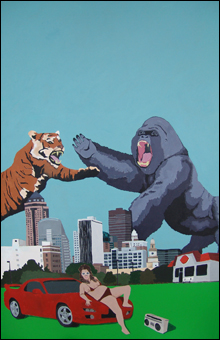
THE GREAT BATTLE FOR DES MOINES
AND MY LOVE: Leslie Hall’s work suggests
that she’s still feeling her way around —but it’s
fun.
|
The theme of MassArt’s “War Stories” is what we talk about when we talk about war — the Iraq War in particular. Tall tales got us into this war, beginning five years ago next month. And as MassArt’s Lisa Tung, who organized “War Stories,” notes in the exhibit’s wall text, we still struggle to locate the war’s facts amid all the confusing data, all the debate, all the spin. The show is deeply depressing because the subjects are so depressing: unheeded warnings, our war-wounded veterans, the black hole of indefinite imprisonment and torture that we’ve created for our war prisoners.
Nina Berman’s eight photos show wounded American veterans of the Iraq War. A man injured by a remote-detonated bomb stands in his dress uniform, with a chest full of medals. His face is all lumps and scars. A man injured in a mortar attack leans against a chain-link fence with his shirt off to reveal a scar creeping from the bottom of his sternum to his groin. A man who lost a leg when a rocket blasted his vehicle exercises his remaining leg in a rehab center. A woman injured in a Humvee accident floats at the edge of a pool.
Texts from interviews with the vets accompany the pictures. They speak of joining up because there was little work, of violence in their community, of the righteousness of deposing Saddam because he “was a bad guy,” of wounded comrades, and of missing the military.
Army Specialist Robert Acosta, who lost his right hand and the use of a leg when an Iraqi teen threw a grenade into his Humvee, is photographed wearing a prosthetic arm and standing in the backyard of a house. “When somebody gets hurt, they’re out of there within hours,” he says. “You hear rumors, you hear stories, some guy got hit . . . but you don’t really see the reality of it until you get there and see them in the hospital.”
“War Stories” Bakalar Gallery at Massachusetts College of Art and Design, 621 Huntington Ave, Boston | Through March 12
“Body Politics: Maori Tattoo Today”
Peabody Essex Museum, East India Square, Salem | Through February 1, 2009.
“SMFA Traveling Scholars” Museum of Fine Arts, 465 Huntington Ave, Boston | Through March 2
|
Berman’s deadpan portraits and interviews are more interesting for what they represent — the hidden wounded of our Iraq War — than for their actual artistry or insight. But her 2006 photo Marine Wedding is a heartbreaking formal portrait of a young bride in her wedding gown next to her wounded groom in his Marine dress uniform. His lips are swollen, his ears have vanished, his nose is deformed, his head is bald and lumpy. Wedding photos are usually about love and hope and youthful promise, but here the fierce reality of the groom’s wounds makes all those pretty ideas seem compromised.
David Thorne, Katya Sander, Ashley Hunt, Sharon Hayes, and Andrea Geyer present 9 Scripts from a Nation at War (2007), one wall-mounted video plus eight desks with built-in video screens. The videos run about eight and a half hours, so I assume the artists intend us to watch only bits and pieces. In one video, a man reads first-person accounts that seem to come from various bloggers. In another, a woman plays a lawyer explaining her work representing Guantánamo prisoners. A man who seems to be a journalist talks about covering war. People read accounts, apparently from veterans, about their training, about war, and about returning home. Women discuss the nature of power.
The artists have said that the piece asks, “How does war construct specific positions for individuals to fill, enact, speak from, or resist?” The stories are flatly performed, mostly in empty classrooms and auditoriums. A four-hour re-enactment of a tribunal questioning detainees pauses now and again for everyone to shift one chair to the right and take a new role. This artifice makes all the tales feel suspect — it suggests we should be wary about what we take to be true. But it also short-circuits emotion. It’s just so meta. The cool, detached style that’s used in 9 Scripts — and that dominates contemporary art — is ill suited to addressing this stuff. The art talks mostly around the subject, without getting to the hot, messy, emotional core of the matter.
Jenny Holzer does better by reproducing grainy US government “War on Terror” documents straight-up. Her five screenprints here were among those she exhibited at Barbara Krakow Gallery on Newbury Street last May. (I reviewed them in detail then, in the June 1 issue of the Phoenix.) One screenprint reproduces White House counterterrorism chief Richard Clarke’s January 2001 warning to Condoleezza Rice about the threat from al-Qaeda. Nearby, then CIA director George Tenet’s September 16, 2001, memo “We’re at War” is printed in emergency red. A handwritten February 2002 report of an Army translator in Afghanistan says that Special Forces soldiers apparently hit, threatened, and shocked with electricity a prisoner he had helped interrogate. Holzer has the authors speak to us directly — even in their own handwriting; the result transmits their worry, their urgency, their shock, their disgust. And in black patches of redacted text, we feel the lurking presence of those in government who would keep these stories untold.